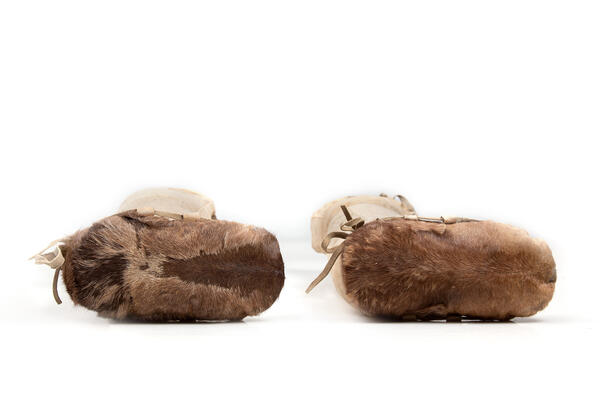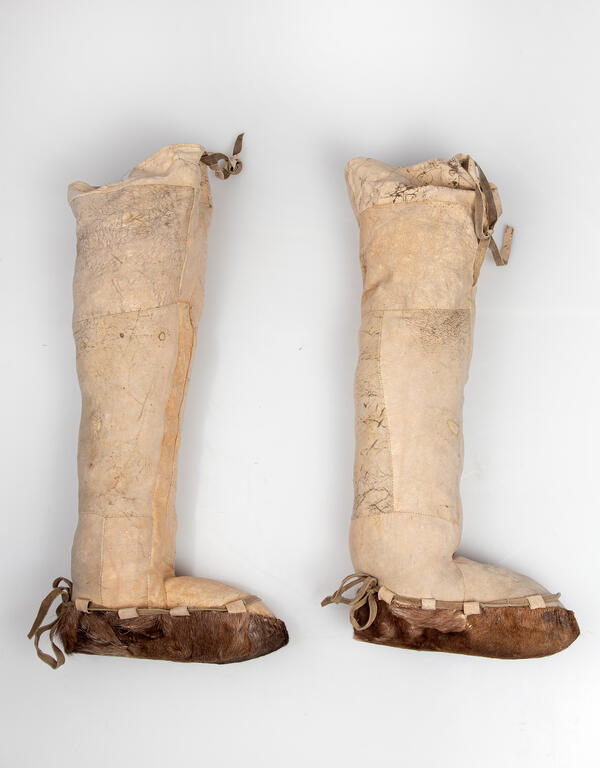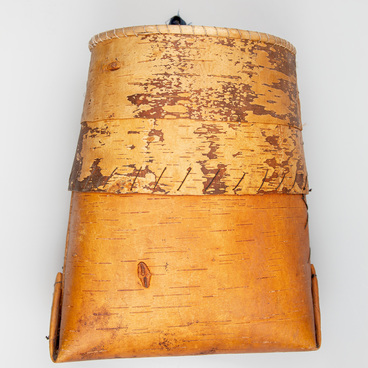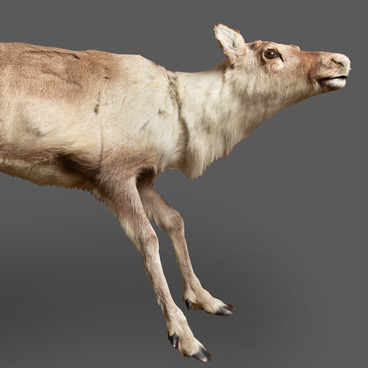Kisy are traditional high boots of the northern peoples, the indigenous inhabitants of Yamal. There are winter and summer, men’s, women’s and children’s kisy, or pimy. All these types of shoes differ in design and materials. Winter kisy are sewn in two layers: stockings with fur inside and boots made of deer skin. The sole of men’s kisy is lined with a stiff pile so that the fur hinders the movement and the wearer does not slip on snow and ice. Women do not have a special sole, because in the Nenets mythology, a woman’s step has an evil power. Kisy are decorated with embroidery, applique made of cloth and fur mosaic. The ornament has a sacred meaning and reveals the character of the owner.
The children’s summer kisy from the collection of the Purovsky Museum are sewn from buckskin (rovduga) — a traditional material of the Nenets people. This is a type of suede made from deer or elk hides, which is prepared in advance. To do this, the deer hide is soaked until the fur begins to come off. Then the hide is moistened with tea leftovers and water, and put on the ground in summer to soak with dew. The remaining fur is removed with a scraper and the skin is dried. Buckskin kisy turn out to be very durable, soft and light.
The Nenets use tendon threads to sew shoes. Such seams do not leak moisture, do not rot and do not stretch. Summer kisy consist of three parts: a piston, a sock and a boot. In the seam of the boot, there are special loops for the strap, which tightly fixes the shoes on the foot. The pile on the sole of the kisy is cut with a knife, and the edges — with scissors, so the fur becomes shorter and neater.
When sewing shoes and clothes using fur, craftswomen always pay attention to the pile: it should be smooth and lead in one direction, from top to bottom. This is necessary so that water droplets from rain, dew and melted snow easily roll down. Otherwise, moisture will accumulate and the skin will rot. This principle emerged from observations of deer. “Fur forward, fur back, ” — that was how the Nenets described unprepossessing deer with fur growing in different directions. Such animals were often weak and sick, and reindeer herders slaughtered them when the animals were still calves.
The children’s summer kisy from the collection of the Purovsky Museum are sewn from buckskin (rovduga) — a traditional material of the Nenets people. This is a type of suede made from deer or elk hides, which is prepared in advance. To do this, the deer hide is soaked until the fur begins to come off. Then the hide is moistened with tea leftovers and water, and put on the ground in summer to soak with dew. The remaining fur is removed with a scraper and the skin is dried. Buckskin kisy turn out to be very durable, soft and light.
The Nenets use tendon threads to sew shoes. Such seams do not leak moisture, do not rot and do not stretch. Summer kisy consist of three parts: a piston, a sock and a boot. In the seam of the boot, there are special loops for the strap, which tightly fixes the shoes on the foot. The pile on the sole of the kisy is cut with a knife, and the edges — with scissors, so the fur becomes shorter and neater.
When sewing shoes and clothes using fur, craftswomen always pay attention to the pile: it should be smooth and lead in one direction, from top to bottom. This is necessary so that water droplets from rain, dew and melted snow easily roll down. Otherwise, moisture will accumulate and the skin will rot. This principle emerged from observations of deer. “Fur forward, fur back, ” — that was how the Nenets described unprepossessing deer with fur growing in different directions. Such animals were often weak and sick, and reindeer herders slaughtered them when the animals were still calves.





